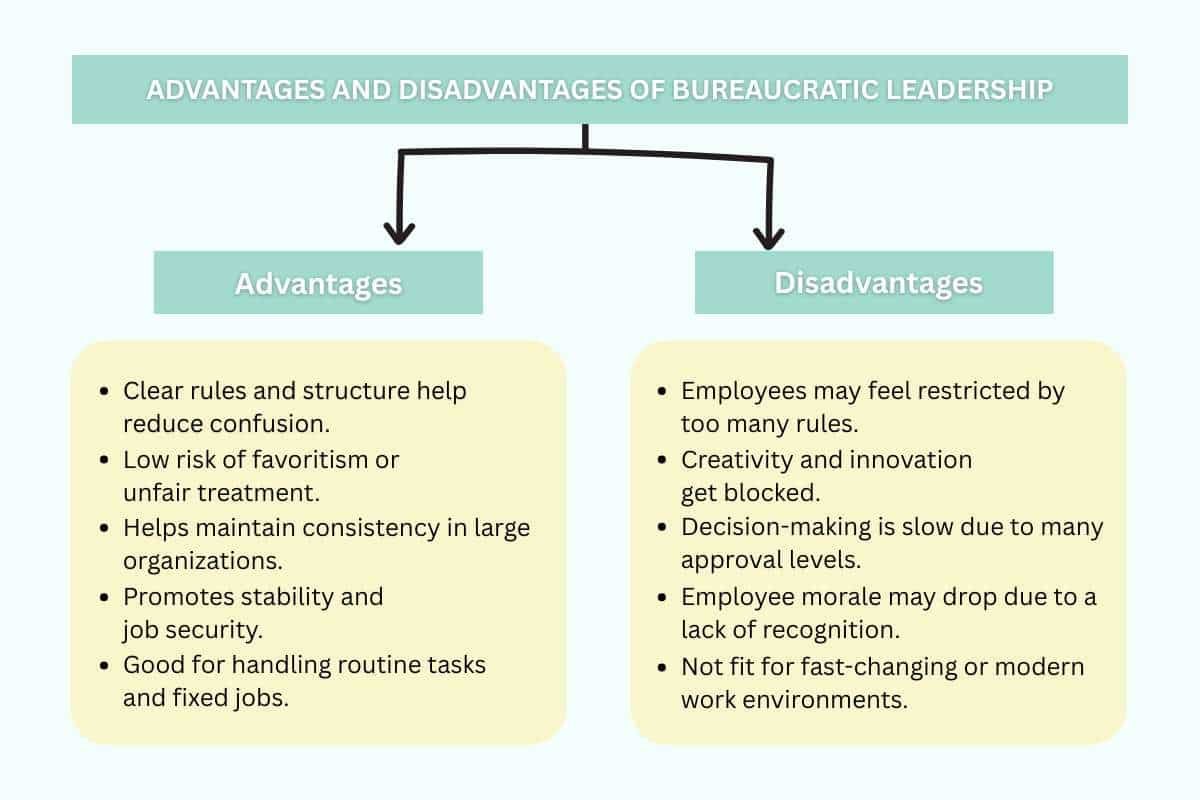Leadership plays a major role in shaping the way people work and achieve goals. Many leadership styles, but Bureaucratic leadership stands out for its strict structure and clear rules. This type of leadership appears in large organizations, government offices, and companies where routine and consistency matter the most. Let’s understand what this leadership style is, its key features, how it affects employees, and the pros and cons that come with it.
What Is Bureaucratic Leadership?
In this leadership style where leaders follow strict rules and policies. They make decisions based on guidelines, not personal ideas or emotions. This type of leadership sticks to the company’s structure. Every person knows their role, and no one goes outside their limits.
Bureaucratic leadership style works best in environments that require control, order, and regulation. Hospitals, military units, and government departments are good examples. In these places, leaders cannot take risks or make fast changes without following a proper process.
In this Leadership, trust lies more in the system than in the leader’s personality. The focus is on doing the job the “Right” way, as defined by the rules.
Characteristics of Bureaucratic Leadership

Some clear signs show that a leader uses the Bureaucratic Leadership style. These features shape how leaders work and how they manage their teams.
1. Rule-Based Decisions
Leaders make choices based on policies, laws, or formal procedures. They rarely depend on personal views or creative thinking.
2. Strict Hierarchy
There is a clear chain of command. Each person knows who to report to and what their role is.
3. Little Room for Innovation
Leaders expect employees to follow set ways. New ideas are not welcome unless approved through formal channels.
4. High Job Security
Because of fixed roles and procedures, employees feel stable in their jobs. Change is rare and slow.
5. Clear Job Roles
Everyone in the organization knows what they are supposed to do. Tasks do not overlap.
6. Focus on Efficiency
Leaders aim to keep things running smoothly. They prefer proven methods over new, risky ones.
Similar Article:
- Lead with Confidence: 40 Transformative Leadership Quotes to Fuel Your Journey to Success
- 7 Best Books on Leadership to Inspire, Motivate, and Lead with Confidence
Style of Bureaucratic Leadership
This Leadership follows a very formal style. Everything goes through the right channel. Communication is top-down. This means leaders give instructions, and employees follow them. There is little back-and-forth discussion.
The leader rarely gets involved in personal matters or emotions. They care more about job performance, attendance, and how well employees follow rules. In this leadership style, you will see the leader:
- Referring to a policy manual
- Checking reports carefully
- Avoiding favoritism
- Expecting everyone to do things exactly as told
There’s no room for bending rules or making exceptions. This can keep work fair and organized, but it might also reduce employee motivation if people feel like they are only following orders without meaning.
Impact of Bureaucratic Leadership on Employees

Leadership affects workers in many ways. Some employees may like the structure and feel secure. Others may find it limiting. This leadership style can lead to a loyal, stable team, but only if employees are happy with the lack of flexibility.
Positive Impacts:
- Job Security: Employees know what to expect. Their role is clear, and their tasks don’t change often.
- Clear Expectations: There is no guessing. Everyone knows the rules and how to succeed.
- Fair Treatment: Because the system treats everyone equally, there is less chance of bias.
Negative Impacts:
- Lack of Creativity: Workers may not share new ideas if they feel it’s not part of the process.
- Low Engagement: Employees might not feel emotionally connected to their work.
- Slow Growth: Career progress may depend on time served rather than talent or ideas.
Advantages and Disadvantages of Bureaucratic Leadership
The structure works well in stable settings, but it may not be suitable for tech firms or startups that need fast changes and flexible thinking. Let’s look at the strengths and weaknesses of Bureaucratic Leadership in a simple table:

| Advantages | Disadvantages |
| Clear rules and structure help reduce confusion. | Employees may feel restricted by too many rules. |
| Low risk of favoritism or unfair treatment. | Creativity and innovation get blocked. |
| Helps maintain consistency in large organizations. | Decision-making is slow due to many approval levels. |
| Promotes stability and job security. | Employee morale may drop due to a lack of recognition. |
| Good for handling routine tasks and fixed jobs. | Not fit for fast-changing or modern work environments. |
Example of Bureaucratic Leadership
A strong example of this Leadership can be found in
- Government departments, such as the postal service. Employees follow strict rules for handling letters and packages. They wear uniforms, arrive on time, and complete tasks in a certain order.
- Another example is the military. Commanders follow a fixed rank system. Orders are passed down clearly, and each person knows their responsibility. There is no room for creative freedom, but the system runs smoothly due to strict discipline.
- You may notice Bureaucratic Leadership in hospitals also. Doctors, nurses, and staff follow set procedures to treat patients. The focus is on avoiding mistakes by following protocols.
When Bureaucratic Leadership Works Best

This Leadership works well in places where mistakes can cause big problems. For example:
- In airline operations, rules and checks must be followed before take-off.
- In pharmaceutical companies, drug creation must follow laws and safety rules.
- In banks, security steps protect customer data and money.
Similar Article:
- The Importance of Strategic Leadership
- Autocratic Leadership: Characteristics, Pros, Cons, and Tips
- Types of Leadership Styles: A Comprehensive Guide
Conclusion
Bureaucratic Leadership is not about being cold or harsh. It’s about ensuring that work gets done the right way, every time. This leadership style has been a backbone in many public services, large firms, and stable industries.
It brings structure, fairness, and security. But it also comes with limits. Creativity, speed, and employee satisfaction can suffer if rules take over everything.
Leaders today should ask: Do my employees need structure or flexibility? The answer depends on the work they do. A mix of leadership styles may help get the best results.
Bureaucratic Leadership still matters, but it works best when balanced with empathy and vision.










